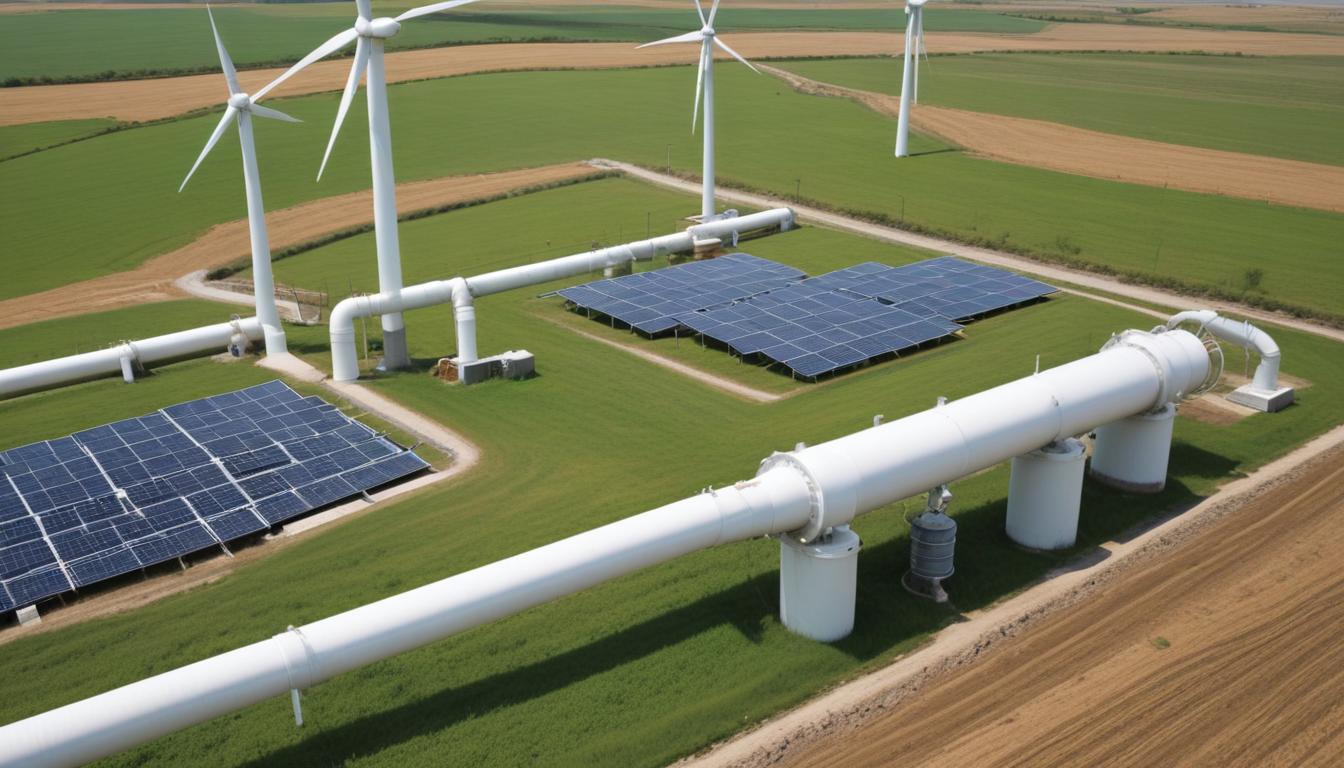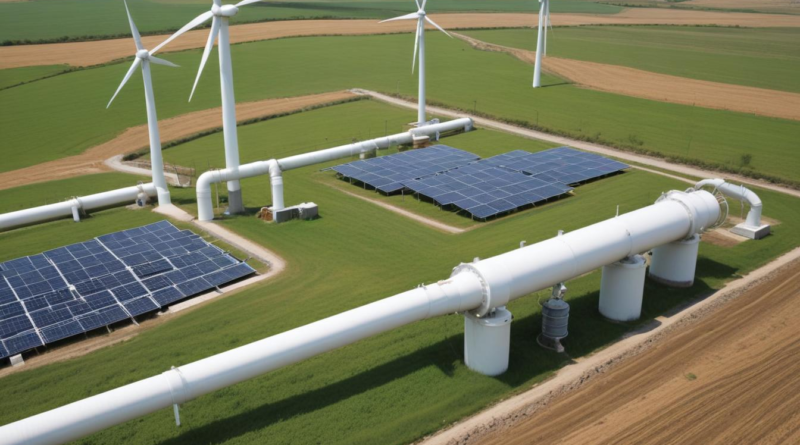the role of pumps in renewable energy systems
Renewable energy systems incorporate a variety of pumps tailored to specific applications and operational requirements. Understanding the different types of renewable energy pumps is essential for optimizing system performance and efficiency. The primary categories include:
| Type of Pump | Operating Principle | Key Features | Common Applications |
|---|---|---|---|
| Centrifugal Pumps | Use rotational energy to transfer fluids | High flow rates, simple design, cost-effective | Hydroelectric power plants, solar thermal systems |
| Positive Displacement Pumps | Move fluid by trapping a fixed amount and forcing it through | Precise flow control, suitable for high viscosity fluids | Geothermal energy extraction, biomass processing |
| Peristaltic Pumps | Compress and release a flexible tube to move fluid | Sanitary applications, easy maintenance, leak-free operation | Biomass fuel handling, water treatment in renewable systems |
| Axial Flow Pumps | Move fluid parallel to the pump shaft | High flow rates, low head applications | Large-scale hydroelectric plants, cooling systems in wind turbines |
| Submersible Pumps | Operate while submerged in the fluid | Compact, efficient in deep wells, reduced risk of cavitation | Geothermal wells, offshore renewable installations |
Additionally, specific renewable energy pumps are designed to meet unique system challenges:
- Solar-Powered Pumps: Utilize photovoltaic cells to drive the pump, eliminating the need for external power sources. Common in remote water pumping and agricultural irrigation.
- Wind-Driven Pumps: Harness wind energy to operate pumps, suitable for pumping water in rural and off-grid areas.
- Pumped Hydro Storage Pumps: Integral to energy storage systems, these pumps transfer water between reservoirs to balance supply and demand in the grid.
The role of each pump type varies depending on the renewable energy source and system design. Selecting the appropriate pump involves considering factors such as energy efficiency, flow rate, head requirements, and environmental conditions. Advances in pump technology continue to enhance the reliability and performance of renewable energy systems, contributing to their broader adoption and integration into the energy mix.
pumps in hydroelectric power systems
In hydroelectric power systems, pumps play a crucial role in both energy generation and storage, particularly within pumped-storage hydroelectricity frameworks. These systems utilize renewable energy pumps to manage the movement of water between upper and lower reservoirs, thereby balancing supply and demand on the electrical grid. The primary functions of these pumps include energy storage during periods of low demand and energy release during peak demand times, enhancing the overall efficiency and reliability of the power grid.
Types of Pumps Used in Hydroelectric Systems:
- Pelton Turbine Pumps: Ideal for high-head applications, these pumps convert the kinetic energy of water into mechanical energy, which is then transformed into electrical energy.
- Francis Pumps: Suitable for medium-head scenarios, Francis pumps offer versatility and are commonly used in large-scale hydroelectric plants.
- Kaplan Pumps: Designed for low-head and high-flow conditions, Kaplan pumps are efficient in tidal and run-of-the-river hydroelectric projects.
Key Applications and Benefits:
| Application | Description | Benefits |
|---|---|---|
| Energy Storage | Pumping water to an upper reservoir during off-peak hours | Stores excess energy, reduces grid instability, enables load balancing |
| Peak Shaving | Releasing stored water to generate electricity during peak demand | Meets high energy demand without the need for additional power plants |
| Grid Regulation | Maintaining consistent energy supply and frequency control | Enhances grid reliability and supports the integration of variable renewable sources |
The integration of advanced pump technologies in hydroelectric systems has led to significant improvements in operational efficiency and capacity. Innovations such as variable speed drives and energy-efficient motor designs contribute to reduced energy consumption and lower operational costs. Additionally, the adaptability of these pumps allows for seamless integration with other renewable energy sources, facilitating a more resilient and flexible energy infrastructure.
Challenges and Considerations:
- Environmental Impact: Ensuring minimal disruption to aquatic ecosystems and surrounding habitats during pump operation.
- Capital Investment: High initial costs associated with the installation and maintenance of large-scale pumping systems.
- Technical Reliability: Ensuring long-term durability and performance of pumps under varying environmental conditions.
Addressing these challenges is essential for the sustainable expansion of hydroelectric power and the effective utilization of pumps in renewable energy systems. Ongoing research and development efforts continue to focus on enhancing pump efficiency, reducing environmental footprint, and lowering costs, thereby reinforcing the pivotal role of pumps in the future of renewable energy.
solar thermal applications of pumps
Solar thermal systems leverage the power of the sun to generate heat, which can then be converted into electricity or used for direct heating applications. The integration of renewable energy pumps is essential in these systems to ensure the efficient transfer and circulation of heat-transfer fluids. These pumps play a pivotal role in maintaining the optimal operation and maximizing the overall efficiency of solar thermal installations.
Types of Pumps Used in Solar Thermal Applications:
- Centrifugal Pumps: Commonly employed due to their ability to handle high flow rates and low to medium head requirements. Their simple design and reliability make them suitable for large-scale solar thermal plants.
- Positive Displacement Pumps: Utilized in applications requiring precise flow control and the handling of viscous heat-transfer fluids. They are ideal for systems where consistent flow rates are critical for performance.
- Submersible Pumps: Used in solar thermal systems with integrated water storage, these pumps operate efficiently while submerged, reducing the risk of cavitation and enhancing energy efficiency.
- Variable Speed Pumps: Incorporate advanced control systems to adjust the pumping speed based on real-time demand, thereby optimizing energy usage and improving system responsiveness.
Key Applications and Benefits:
| Application | Description | Benefits |
|---|---|---|
| Heat Transfer Fluid Circulation | Pumping heat-transfer fluids (such as water, glycol mixtures, or molten salts) through solar collectors to absorb and transport thermal energy. | Ensures efficient heat collection, maintains consistent temperature levels, and enhances overall system performance. |
| Thermal Energy Storage | Circulating fluids between the solar collectors and thermal storage units to store excess heat for later use. | Enables continuous energy supply even during periods of low sunlight, increasing the reliability and flexibility of solar thermal systems. |
| Integration with Power Generation | Facilitates the transfer of thermal energy to power generation units, such as steam turbines or organic Rankine cycle systems. | Optimizes the conversion of thermal energy into electrical energy, improving the overall efficiency of power generation. |
Advantages of Using Pumps in Solar Thermal Systems:
- Enhanced Efficiency: Effective fluid circulation ensures maximum heat absorption and minimal thermal losses, leading to higher system efficiency.
- Operational Flexibility: Variable speed and advanced control pumps allow for dynamic adjustments based on real-time thermal demands and environmental conditions.
- Energy Savings: Energy-efficient pump designs reduce the overall energy consumption of the system, contributing to lower operational costs.
- Reliability and Durability: Robust pump mechanisms designed for continuous operation under varying temperatures and flow rates ensure long-term performance and minimal maintenance requirements.
Challenges and Considerations:
- Thermal Stability: Pumps must be capable of handling high-temperature fluids without degradation, necessitating the use of materials and components that can withstand thermal stresses.
- Corrosion Resistance: Exposure to various heat-transfer fluids can lead to corrosion; selecting pumps with appropriate materials or protective coatings is essential to prolong their lifespan.
- System Integration: Ensuring seamless integration of pumps with other system components and control mechanisms requires careful design and compatibility considerations.
- Initial Investment: High-efficiency and specialized pump technologies may entail significant upfront costs, which need to be justified by long-term savings and performance benefits.
Advancements in pump technology continue to drive improvements in solar thermal applications. Innovations such as smart pumps with integrated sensors and automation capabilities enable more precise control and monitoring, further enhancing system efficiency and reliability. Additionally, ongoing research into materials and design optimizations is expected to reduce costs and improve the sustainability of pumps used in renewable energy systems. By addressing these challenges and leveraging technological advancements, renewable energy pumps will remain a critical component in the advancement and scalability of solar thermal technologies.
pumps in wind energy systems
 In wind energy systems, pumps are integral for various functions that ensure the efficient operation and maintenance of wind turbines and associated infrastructure. These pumps facilitate cooling mechanisms, liquid lubrication processes, and the management of hydraulic systems within wind turbines. Their role is pivotal in maintaining optimal performance, enhancing reliability, and extending the lifespan of wind energy installations.
In wind energy systems, pumps are integral for various functions that ensure the efficient operation and maintenance of wind turbines and associated infrastructure. These pumps facilitate cooling mechanisms, liquid lubrication processes, and the management of hydraulic systems within wind turbines. Their role is pivotal in maintaining optimal performance, enhancing reliability, and extending the lifespan of wind energy installations.
Types of Pumps Used in Wind Energy Systems:
- Gear Pumps: Commonly used in hydraulic systems of wind turbines, gear pumps provide consistent and reliable fluid transfer essential for controlling blade pitch and yaw mechanisms.
- Centrifugal Pumps: Utilized for cooling purposes, centrifugal pumps circulate cooling fluids to dissipate heat generated by electrical components and mechanical systems.
- Peristaltic Pumps: Employed in lubrication systems, these pumps ensure a steady supply of lubricants to reduce friction and wear in moving parts.
- Submersible Pumps: Used in offshore wind farms, submersible pumps manage the movement of fluids in submerged environments, aiding in the maintenance of underwater components.
- Positive Displacement Pumps: Ideal for applications requiring precise flow control, these pumps are used in various control systems within wind turbines to manage hydraulic fluid paths.
Key Applications and Benefits:
| Application | Description | Benefits |
|---|---|---|
| Cooling Systems | Pumps circulate cooling fluids to maintain optimal temperatures of electrical generators and power electronics. | Prevents overheating, enhances component longevity, and ensures reliable energy production. |
| Hydraulic Control Systems | Manage the movement and positioning of turbine blades and nacelle components through precise fluid control. | Enables accurate and responsive control of turbine operations, maximizing energy capture and efficiency. |
| Lubrication Systems | Provide consistent lubrication to mechanical parts, reducing friction and preventing wear and tear. | Extends the lifespan of turbine components, reduces maintenance costs, and minimizes downtime. |
| Offshore Maintenance | Facilitate the transfer and management of fluids for the maintenance and repair of submerged wind turbine parts. | Enhances the accessibility and efficiency of offshore wind farm operations, ensuring timely maintenance. |
Advantages of Using Pumps in Wind Energy Systems:
- Enhanced Efficiency: Effective fluid management ensures that all systems operate within their optimal parameters, maximizing energy output.
- Operational Reliability: Reliable pump performance reduces the risk of system failures, ensuring continuous energy production.
- Maintenance Optimization: Automated pump systems allow for proactive maintenance scheduling, minimizing unexpected downtimes.
- Energy Savings: Efficient pump designs contribute to lower overall energy consumption of the wind turbine systems.
- Scalability: Modular pump systems can be easily scaled to accommodate different sizes and capacities of wind turbines.
Challenges and Considerations:
- Environmental Conditions: Pumps in wind energy systems, especially offshore, must withstand harsh environmental conditions such as saltwater corrosion, extreme temperatures, and high winds.
- Energy Efficiency: Balancing pump performance with energy consumption is crucial to ensure that the pumps do not significantly detract from the overall energy generation.
- Maintenance Accessibility: Designing pump systems that are easily accessible for maintenance and repairs is essential to minimize downtime and operational costs.
- Integration with Control Systems: Ensuring seamless integration of pumps with the turbine’s control systems is vital for synchronized operations and optimal performance.
- Cost Considerations: High initial investment costs for advanced pump technologies must be justified by long-term benefits such as improved efficiency and reduced maintenance costs.
Advancements in pump technology are continuously enhancing their applications within wind energy systems. Innovations such as smart pumps with integrated sensors and IoT connectivity enable real-time monitoring and predictive maintenance, thereby increasing the reliability and efficiency of wind turbines. Additionally, the development of energy-efficient pump designs contributes to the overall sustainability of wind energy projects, making renewable energy pumps an indispensable component in the advancement of wind power technology.
future developments in pump technology
Advancements in pump technology are pivotal in enhancing the efficiency, reliability, and sustainability of renewable energy systems. Emerging innovations are driving the evolution of renewable energy pumps, addressing current limitations and opening new avenues for their applications across various renewable sectors.
Technological Innovations
The development of new materials and engineering techniques is at the forefront of pump technology advancements. Modern pumps are increasingly utilizing corrosion-resistant alloys and lightweight composites to improve durability and reduce maintenance requirements. Additionally, 3D printing and additive manufacturing are enabling the creation of complex pump components with optimized geometries, enhancing performance while minimizing material usage.
Energy Efficiency Enhancements
Improving energy efficiency remains a critical focus in pump technology. The integration of variable speed drives (VSDs) allows pumps to adjust their operational speed in real-time based on demand, significantly reducing energy consumption. Magnetic levitation (maglev) technology is also being explored to minimize friction losses, thereby enhancing overall pump efficiency. These advancements not only lower operational costs but also contribute to the sustainability of renewable energy systems by reducing their carbon footprint.
Smart and Connected Pumps
The incorporation of Internet of Things (IoT) technology is transforming pumps into intelligent devices capable of real-time monitoring and data analytics. Smart pumps equipped with sensors can provide continuous feedback on performance parameters such as flow rate, pressure, and temperature. This data facilitates predictive maintenance, allowing for the early detection of potential issues and minimizing downtime. Additionally, remote monitoring capabilities enable operators to manage pump performance from centralized control systems, enhancing overall system responsiveness and efficiency.
Enhanced Reliability and Lifespan
Innovations aimed at improving the reliability and lifespan of pumps are critical for the long-term sustainability of renewable energy systems. Advanced sealing technologies reduce leakage and wear, extending the operational life of pumps. Self-diagnostic features integrated into pump control systems enable continuous assessment of pump health, ensuring timely maintenance and reducing the likelihood of unexpected failures. These enhancements contribute to the overall robustness and dependability of renewable energy infrastructures.
Integration with Renewable Energy Sources
Future pump technologies are being designed to seamlessly integrate with a variety of renewable energy sources. Solar-powered pumps with optimized photovoltaic integration maximize energy utilization from solar arrays, while wind-driven pumps are being refined to operate efficiently under varying wind conditions. Additionally, pumps for pumped hydro storage are evolving to handle greater capacities and more rapid cycling, thereby enhancing their role in energy storage and grid stabilization.
Sustainability and Eco-Friendly Manufacturing
The push towards sustainability extends to the manufacturing processes of pumps. Eco-friendly materials and green manufacturing practices are being adopted to reduce the environmental impact of pump production. Recyclable components and energy-efficient manufacturing techniques ensure that the life cycle of pumps aligns with the broader goals of renewable energy systems. These practices not only support environmental stewardship but also appeal to increasingly eco-conscious markets.
Cost Reduction Strategies
Reducing the cost of pump technology is essential for broader adoption in renewable energy systems. Modular pump designs allow for scalable installations, reducing upfront costs and enabling customization based on specific system requirements. Automation and streamlined manufacturing processes lower production costs, making advanced pumps more accessible to a wider range of applications. Additionally, mass production of standardized components drives down prices through economies of scale, facilitating the integration of high-performance pumps in various renewable energy projects.
Future Trends and Opportunities
| Trend | Description | Potential Impact |
|---|---|---|
| Artificial Intelligence Integration | Utilizing AI algorithms for optimizing pump performance and predictive maintenance. | Increased operational efficiency and reduced downtime. |
| Energy Harvesting Pumps | Pumps that can generate energy while operating, contributing to the power supply of renewable systems. | Enhanced energy self-sufficiency and reduced external energy dependencies. |
| Biomimetic Pump Designs | Inspired by natural systems, these designs aim to improve flow dynamics and energy efficiency. | Innovative performance improvements and new application possibilities. |
| Advanced Control Systems | Integration of sophisticated control mechanisms for real-time optimization of pump operations. | Maximized system performance and adaptability to changing conditions. |
Research and Development Directions
Ongoing research is exploring novel pump designs and operating principles tailored specifically for renewable energy applications. For instance, magnetic bearing pumps eliminate the need for traditional bearings, reducing maintenance and increasing efficiency. Additionally, bio-inspired pumping mechanisms mimic natural processes to achieve greater energy efficiency and adaptability. Collaborative efforts between academia, industry, and government institutions are accelerating the pace of innovation, ensuring that future pump technologies meet the evolving demands of renewable energy systems.
Conclusion
The future of pump technology is intrinsically linked to the advancement and scalability of renewable energy systems. By focusing on energy efficiency, smart connectivity, material innovations, and sustainable practices, the next generation of renewable energy pumps will play a critical role in driving the global transition towards a more sustainable and resilient energy landscape. Continued investment in research and development, coupled with strategic collaborations, will unlock new applications and enhance the overall effectiveness of renewable energy infrastructures worldwide.



